
In association football, kit (also referred to as a strip or uniform) is the standard equipment and attire worn by players. The sport's rules specify the minimum kit which a player must use, and also prohibit the use of anything that is dangerous to either the player or another participant. Individual competitions may stipulate further restrictions, such as regulating the size of logos displayed on shirts and stating that, in the event of a match between teams with identical or similar colours, the away team must change to different coloured attire, to avoid clashes.
Footballers generally wear identifying numbers on the backs of their shirts. Originally a team of players wore numbers from 1 to 11, corresponding roughly to their playing positions, but at the professional level this has generally been superseded by squad numbering, whereby each player in a squad is allocated a fixed number for the duration of a season. Professional clubs also usually display players' surnames or nicknames on their shirts, above (or, infrequently, below) their squad numbers.
Football kit has evolved significantly since the early days of the sport when players typically wore thick cotton shirts, knickerbockers and heavy rigid leather boots. In the twentieth century, boots became lighter and softer, shorts were worn at a shorter length, and advances in clothing manufacture and printing allowed shirts to be made in lighter synthetic fibres with increasingly colourful and complex designs. With the rise of advertising in the 20th century, sponsors' logos began to appear on shirts, and replica strips were made available for fans to purchase, generating significant amounts of revenue for clubs.
Equipment
Basic equipment
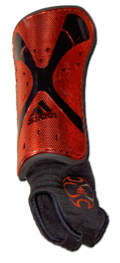
The rules set out the basic equipment which must be worn by all players in Law 4 (Players' Equipment). Five separate items are specified: shirt (also known as a jersey), shorts, socks (also known as stockings), footwear and shin pads. Goalkeepers are allowed to wear tracksuit bottoms instead of shorts.
While most players wear studded football boots ("soccer shoes" or "cleats" in North America), the Laws do not specify that these are required. Shirts must have sleeves (both short and long sleeves are accepted), and goalkeepers must wear shirts which are easily distinguishable from all other players and the match officials. Thermal undershorts may be worn, but must be the same colour as the shorts themselves. Shin pads must be covered entirely by the stockings, be made of rubber, plastic or a similar material, and "provide a reasonable degree of protection". The only other restriction on equipment defined is the requirement that a player must not use equipment or wear anything deemed dangerous to himself or another player.
It is normal for individual competitions to specify that all outfield players on a team must wear the same colours, though the Law states only "The two teams must wear colours that distinguish them from each other and also the referee and the assistant referees". In the event of a match between teams who would normally wear identical or similar colours the away team must change to a different colour. Because of this requirement a team's second-choice is often referred to as its "away kit" or "away colours", although it is not unknown, especially at international level, for teams to opt to wear their away colours even when not required to by a clash of colours, or to wear them when they are the home team. The England national team sometimes plays in red shirts even when their white standard kit does not clash with their opponent, as this was the strip worn when the team won the 1966 FIFA World Cup. In some cases both teams have been forced (or chose) to wear their second choice away kits; such as the match between Netherlands and Brazil in the 1974 FIFA World Cup where they wore white and dark blue rather than their first choice of orange and yellow, respectively; and the match between Netherlands and Spain in the 2014 FIFA World Cup where they wore dark blue and white rather than their home colors of orange and red, respectively. Many professional clubs also have a "third kit", ostensibly to be used if both their first-choice and away colours are deemed too similar to those of an opponent.
Most professional clubs have retained the same basic colour scheme for several decades, and the colours themselves form an integral part of a club's culture. Teams representing countries in international competition generally wear national colours in common with other sporting teams of the same nation. These are usually based on the colours of the country's national flag, although there are exceptions—the Italy national team, for example, wear blue as it was the colour of the House of Savoy, the Australian team like most Australian sporting teams wear the Australian National Colours of green and gold, neither of which appear on the flag, and the Dutch national team wear orange, the colour of the Dutch Royal House.
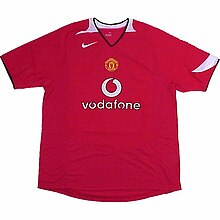
Shirts are normally made of a polyester mesh, which does not trap the sweat and body heat in the same way as a shirt made of a natural fibre. Most professional clubs have sponsors' logos on the front of their shirts, which can generate significant levels of income, and some also offer sponsors the chance to place their logos on the back of their shirts. Depending on local rules, there may be restrictions on how large these logos may be or on what logos may be displayed. Competitions such as the Premier League may also require players to wear patches on their sleeves depicting the logo of the competition. A player's number is usually printed on the back of the shirt, although international teams often also place numbers on the front, and professional teams generally print a player's surname above their number. The captain of each team is usually required to wear an elasticated armband around the left sleeve to identify them as the captain to the referee and supporters.

Most current players wear specialist football boots, which can be made either of leather or a synthetic material. Modern boots are cut slightly below the ankles, as opposed to the high-ankled boots used in former times, and have studs attached to the soles. Studs may be either moulded directly to the sole or be detachable, normally by means of a screw thread. Modern boots such as the Adidas Predator, originally designed by former Liverpool player Craig Johnston, feature increasingly intricate, scientifically aided designs and features such as air pockets in the soles and rubber "blades" on the sole rather than studs. The blades have been the subject of controversy as several top managers have blamed them for injuries both to opposition players and to the wearers themselves.
The rules specify that all players, regardless of gender, must wear the same kit, however in September 2008 the Dutch women's team FC de Rakt made international headlines by swapping its old strip for a new one featuring short skirts and tight-fitting shirts. This innovation, which had been requested by the team itself, was initially vetoed by the KNVB, Dutch football's governing body, but this decision was reversed when it was revealed that the FC de Rakt team were wearing hot pants (very short shorts) under their skirts, and were therefore technically in compliance.
Other equipment
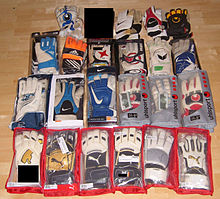
All players are permitted to wear gloves, and goalkeepers usually wear specialist goalkeeping gloves. Prior to the 1970s gloves were rarely worn, but it is now extremely unusual to see a goalkeeper without gloves. In Portugal's match against England in the Euro 2004 tournament, Ricardo drew much comment for deciding to remove his gloves during the penalty shoot-out. Since the 1980s significant advancements have been made in the design of gloves, which now feature protectors to prevent the fingers bending backwards, segmentation to allow greater flexibility, and palms made of materials designed to protect the hand and to enhance a player's grip. Gloves are available in a variety of different cuts, including "flat palm", "roll finger" and "negative", with variations in the stitching and fit. Goalkeepers sometimes also wear caps to prevent glare from the sun or floodlights affecting their performance. Players with sight problems may wear glasses as long as there is no risk of them falling off or breaking and thereby becoming dangerous. Most players affected choose to wear contact lenses, although Dutch player Edgar Davids, unable to wear contact lenses due to glaucoma, was known for his distinctive wraparound goggles. Other items that may be dangerous to other players, such as jewellery, however, are not allowed. Players may also choose to wear headgear to protect themselves from head injury, or to prevent further such injuries, such as Petr Čech and Cristian Chivu's use of rugby helmets, as long as it presents no risk to the safety of the wearer or any other player.
Match officials' kit

Referees, assistant referees and fourth officials wear kits of a similar style to that worn by players; until the 1950s it was more common for a referee to wear a blazer than a jersey. Officials wear shirts of a different colour to those worn by the two teams and their goalkeepers. Black is the traditional colour worn by officials, and "the man in black" is widely used as an informal term for a referee, although increasingly other colours are being used in the modern era to minimise colour clashes. The 1994 World Cup was the first in which FIFA dispensed with black kits for officials. Referees also sometimes have sponsors' logos on their shirts, although these are normally confined to the sleeves.
History
Victorian era
The first written evidence of a clothing item specifically dedicated to football comes in 1526, from the Great Wardrobe of King Henry VIII of England, which included a reference to a pair of football boots. The earliest evidence of coloured shirts used to identify football teams comes from early English public school football games, for example an image of Winchester College football from before 1840 is entitled "The commoners have red and the college boys blue jerseys" and such colours are mentioned again in a Bell's Life in London article of 1858. House sporting colours are mentioned in Rugby football (rule XXI) as early as 1845: "No player may wear cap or jersey without leave from the head of his house". In 1848, it was noted at Rugby that "considerable improvement has taken place in the last few years, in the appearance of a match... in the use of peculiar dress consisting of velvet caps and jerseys".
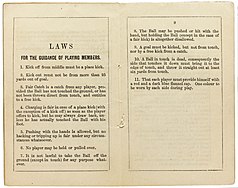 Sheffield rules requiring coloured caps
Sheffield rules requiring coloured caps
Organised association football was first played in England in the 1860s, and many teams would probably play in whatever clothing they had available, with players of the same team distinguishing themselves by wearing coloured caps or sashes. The Sheffield club rules in 1857 required members to acquire one red and one dark blue cap, in order to form teams within the membership for matches, and a report of a match between Sheffield and Hallam & Stumperlow in 1860 refers to the Sheffield side wearing their "usual scarlet and white", and the Hallam players a "blue garment". One report of an 1860 match played to an indeterminate code, between Spalding Football Club and Spalding Victoria, refers to Spalding as the "pinks" and Victoria as the "blues".
Limiting colours simply to caps or sashes proved to be problematic though, and an 1867 handbook of the game suggested that teams should attempt "if it can be previously so arranged, to have one side with striped jerseys of one colour, say red, and the other with another, say blue. This prevents confusion and wild attempts to wrest the ball from your neighbour." The Charles Alcock football yearbooks from 1868 also included return forms which asked club secretaries to include details of club colours.

The first standard strips emerged with the founding of the FA, the Football Association's initial minutes recording some of the club colours, such as the Royal Engineers A.F.C.'s red and blue, and Lincoln's white jerseys with red, white, and blue caps. Many clubs opted for colours associated with the schools or other sporting organisations from which the clubs had emerged. Blackburn Rovers, for example, adopted shirts of a halved design based on those of the team for former pupils of Malvern College, one of the schools where the sport had developed. Their original colours of light blue and white were chosen to reflect an association with Cambridge University, where a number of the club's founders had been educated. Colours and designs often changed dramatically between matches, with Bolton Wanderers turning out in both pink shirts and white shirts with red spots within the same year. Rather than the modern shorts, players wore long knickerbockers or full-length trousers, often with a belt or even braces. Lord Kinnaird, an early star of the game, was noted for always being resplendent in long white trousers. There were no numbers printed on shirts to identify individual players, and the programme for an 1875 match between Queen's Park and Wanderers in Glasgow identifies the players by the colours of their caps or stockings. The first shin pads were worn in 1874 by the Nottingham Forest player Sam Weller Widdowson, who cut down a pair of cricket pads and wore them outside his stockings. Initially the concept was ridiculed but it soon caught on with other players. By the turn of the century pads had become smaller and were being worn inside the stockings.
As the game gradually moved away from being a pursuit for wealthy amateurs to one dominated by working-class professionals, kits changed accordingly. The clubs themselves, rather than individual players, were now responsible for purchasing kit and financial concerns, along with the need for the growing numbers of spectators to easily identify the players, led to the lurid colours of earlier years being abandoned in favour of simple combinations of primary colours. In 1890, the Football League, which had been formed two years earlier, ruled that no two member teams could register similar colours, so as to avoid clashes. This rule was later abandoned in favour of one stipulating that all teams must have a second set of shirts in a different colour available. Initially the home team was required to change colours in the event of a clash, but in 1921 the rule was amended to require the away team to change.
Specialised football boots began to emerge in the professional era, taking the place of everyday shoes or work boots. Players initially simply nailed strips of leather to their boots to enhance their grip, leading the Football Association to rule in 1863 that no nails could project from boots. By the 1880s these crude attachments had become studs. Boots of this era were made of heavy leather, had hard toecaps, and came high above a player's ankles.
Early 20th century
As the game began to spread to Europe and beyond, clubs adopted kits similar to those worn in the United Kingdom, and in some cases chose colours directly inspired by British clubs. In 1903, Juventus of Italy adopted a black and white strip inspired by Notts County. Two years later, Argentina's Club Atlético Independiente adopted red shirts after watching Nottingham Forest play.
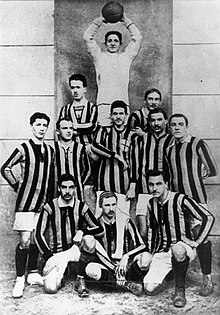
In 1904, the Football Association dropped its rule that players' knickerbockers must cover their knees and teams began wearing them much shorter. They became known as "knickers", and were referred to by this term until the 1960s when "shorts" became the preferred term. Initially, almost all teams wore knickers of a contrasting colour to their shirts. In 1909, in a bid to assist referees in identifying the goalkeeper amongst a ruck of players, the rules were amended to state that the goalkeeper must wear a shirt of a different colour to their team-mates. Initially it was specified that goalkeepers' shirts must be either scarlet or royal blue, but when green was added as a third option in 1912 it caught on to the extent that soon almost every goalkeeper was playing in green. In this period goalkeepers generally wore a heavy woollen garment more akin to a jumper than the shirts worn by outfield players.
Sporadic experiments with numbered shirts took place in the 1920s but the idea did not initially catch on. The first major match in which numbers were worn was the 1933 FA Cup Final between Everton and Manchester City. Rather than the numbers being added to the clubs' existing strips, two special sets, one white and one red, were made for the final and allocated to the two teams by the toss of a coin. The Everton players wore numbers 1–11, while the City players wore 12–22. It was not until around the time of the Second World War that numbering became standard, with teams wearing numbers 1–11. Although there were no regulations on which player should wear which number, specific numbers came to be associated with specific positions on the field of play, examples of which were the number 9 shirt for the team's main striker and the number 1 shirt for the goalkeeper. In contrast to the usual practice, Scottish club Celtic wore numbers on their shorts rather than their shirts until 1975 for international matches, and until 1994 for domestic matches. The 1930s also saw great advancements in boot manufacture, with new synthetic materials and softer leathers becoming available. By 1936 players in Europe were wearing boots which weighed only a third of the weight of the rigid boots of a decade earlier, although British clubs did not adopt the new-style boots, with players such as Billy Wright openly pronouncing their disdain for the new footwear and claiming that it was more suited to ballet than football.

In the period immediately after the war, many teams in Europe were forced to wear unusual kits due to clothing restrictions. England's Oldham Athletic, who had traditionally worn blue and white, spent two seasons playing in red and white shirts borrowed from a local rugby league club, and Scotland's Clyde wore khaki. In the 1950s kits worn by players in southern Europe and South America became much more lightweight, with V-necks replacing collars on shirts and synthetic fabrics replacing heavy natural fibres. The first boots to be cut below the ankle rather than high-topped were introduced by Adidas in 1954. Although they cost twice as much as existing styles, the boots were a huge success and cemented the German company's place in the football market. Around the same time Adidas also developed the first boots with screw-in studs which could be changed according to pitch conditions. Other areas were slower to adopt the new styles – British clubs again resisted change and stuck resolutely to kits little different from those worn before the war, and Eastern European teams continued to wear kits that were deemed old-fashioned elsewhere. The FC Dynamo Moscow team that toured Western Europe in 1945 drew almost as much comment for the players' long baggy shorts as for the quality of their football. With the advent of international competitions such as the European Cup, the southern European style spread to the rest of the continent and by the end of the decade the heavy shirts and boots of the pre-war years had fallen entirely out of use. The 1960s saw little innovation in kit design, with clubs generally opting for simple colour schemes which looked good under the newly adopted floodlights. Designs from the late 1960s and early 1970s are highly regarded by football fans.
Modern era
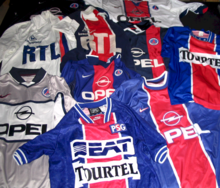
In the 1970s, clubs began to create strongly individual strips, and in 1975, Leeds United, who had changed their traditional blue and gold colours to all white in the 1960s to mimic Real Madrid, became the first club to design shirts which could be sold to fans in the form of replicas. Driven by commercial concerns, other clubs soon followed suit, adding manufacturers' logos and a higher level of trim. In 1973, German team Eintracht Braunschweig signed a deal with local alcohol producer Jägermeister to display its logo on the front of their shirts. Soon almost all major clubs had signed such deals, and the cost to companies who sponsor large teams has increased dramatically. In 2008 German club FC Bayern Munich received €25 million in sponsorship money from Deutsche Telekom. However Spanish clubs FC Barcelona and Athletic Bilbao refused to allow sponsors' logos to appear on their shirts as recently as 2005. Until 2011 Barcelona refused paying sponsors in favour of wearing the UNICEF logo on their shirts while donating €1.5 million to the charity per year. Players also began to sign sponsorship deals with individual companies. In 1974 Johan Cruijff refused to wear the Dutch national team's strip as its Adidas branding conflicted with his own individual contract with Puma, and was permitted to wear a version without the Adidas branding. Puma had also paid Pelé $120,000 to wear their boots and specifically requested that he bend down and tie his laces at the start of the 1970 FIFA World Cup final, ensuring a close-up of the boots for a worldwide television audience. In the 1970s, the U.S.-based North American Soccer League experimented with printing players' names on their shirts and allocating each player a squad number rather than simply numbering the 11 players starting a game from 1 to 11, but these ideas did not catch on at the time in other countries. On 22 August 1979, during a 1979–80 Coppa Italia game against AC Milan, Italian team Monza displayed the players' names above the numbers on the back, a novelty at the time dubbed "all'Americana" (American style); the Italian Football Federation did not approve of the change and fined the club. Shortly after, AC Milan themselves added names to players' shirts in 1980. The names were removed in 1981 and for many years they would not be adopted by any other team in Italy.
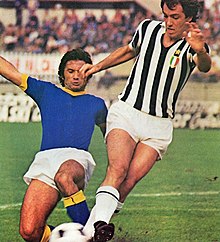
In the 1980s, manufacturers such as Hummel and Adidas began to design shirts with increasingly intricate designs, as new technology led to the introduction of such design elements as shadow prints and pinstripes. Hummel's distinctive halved strip designed for the Danish national team for the 1986 FIFA World Cup caused a stir in the media but FIFA worried about moiré artefacts in television pictures. Shorts became shorter than ever during the 1970s and 1980s, and often included the player's number on the front. In the 1991 FA Cup Final Tottenham Hotspur's players lined up in long baggy shorts. Although, the new look was derided, clubs in Britain and elsewhere had within a short time adopted the longer shorts. In the 1990s shirt designs became increasingly complex, with many teams sporting extremely gaudy colour schemes. Design decisions were increasingly driven by the need for the shirt to look good when worn by fans as a fashion item, but many designs from this era have since come to be regarded as amongst the worst of all time. In 1996, Manchester United notoriously introduced a grey strip which had been specifically designed to look good when worn with jeans, but abandoned it halfway through a match after manager Alex Ferguson claimed that the reason why his team was losing 3–0 was that the players could not see each other on the pitch. United switched to different colours for the second half and scored one goal without reply. The leading leagues also introduced squad numbers, whereby each player is allocated a specific number for the duration of a season. A brief fad arose for players celebrating goals by lifting or completely removing their shirts to reveal political, religious or personal slogans printed on undershirts. This led to a ruling from the International Football Association Board in 2002 that undershirts must not contain slogans or logos; since 2004 it has been a bookable offence for players to remove their shirts.
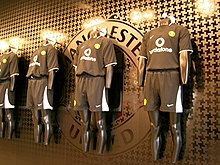
The market for replica shirts has grown enormously, with the revenue generated for leading clubs and the frequency with which they change designs coming under increased scrutiny, especially in the United Kingdom, where the market for replicas is worth in excess of £200m. Several clubs have been accused of price fixing, and in 2003 Manchester United were fined £1.65m by the Office of Fair Trading. The high prices charged for replicas have also led to many fans buying fake shirts which are imported from countries such as Thailand and Malaysia.
The chance for fans to purchase a shirt bearing the name and number of a star player can lead to significant revenue for a club. In the first six months after David Beckham's transfer to Real Madrid the club sold more than one million shirts bearing his name. A market has also developed for shirts worn by players during significant matches, which are sold as collector's items. The shirt worn by Pelé in the 1970 FIFA World Cup Final sold at auction for over £150,000 in 2002.
A number of advances in kit design have taken place since 2000, with varying degrees of success. In 2002 the Cameroon national team competed in the African Cup of Nations in Mali wearing shirts with no sleeves, but FIFA later ruled that such garments were not considered to be shirts and therefore were not permitted. Manufacturers Puma AG initially added "invisible" black sleeves to comply with the ruling, but later supplied the team with new one-piece singlet-style tops. FIFA ordered the team not to wear the tops but the ruling was disregarded, with the result that the Cameroon team was docked six points in its qualifying campaign for the 2006 FIFA World Cup, a decision later reversed after an appeal. More successful were the skin-tight shirts designed for the Italian national team by manufacturers Kappa, a style subsequently emulated by other national teams and club sides.
A brief fashion for men wearing snood scarf neckwarmers ended in 2011 when the IFAB banned them as potentially dangerous. A ban on women wearing the hijab was introduced by the IFAB in 2007, but lifted in 2012 after pressure from Prince Ali of Jordan. In keeping with French views, the French Football Federation said it would maintain its ban.
See also
Further reading
- Butler, David; Butler, Robert (2021). "The evolution of the football jersey – an institutional perspective". Journal of Institutional Economics. 17 (5): 821–835. doi:10.1017/S1744137421000278. hdl:10468/11295.
References
- ^ "Law 4 – The Players' Equipment" (PDF). Laws of the Game 2008/2009. FIFA. pp. 18–19. Archived from the original (PDF) on 8 September 2008. Retrieved 1 September 2008.
- "Interpretation of the laws of the game and guidelines for referees: Law 4 – The Players' Equipment" (PDF). Laws of the Game 2010/2011. FIFA. p. 63. Archived from the original (PDF) on 28 June 2021. Retrieved 21 December 2014.
- "soccer player". Visual Dictionary Online. Merriam-Webster. Archived from the original on 4 April 2021. Retrieved 28 April 2009.
- ^ Crisfield, Deborah (1999). The complete idiot's guide to soccer. The Complete Idiot's Guide to... Alpha Books. p. 47. ISBN 978-0-02-862725-0.
- "Standardised League Rules". Wessex Football League. Archived from the original on 6 March 2008. Retrieved 16 January 2008.
- Glen Isherwood; et al. "England's Uniforms – Player Kits". England Football Online. Archived from the original on 15 January 2008. Retrieved 23 January 2008.
England sometimes choose to wear their red at home even though they could wear their white, as against Germany in the last match played at Wembley Stadium. The Football Association wished to invoke the spirit of 1966, when, in their finest moment at Wembley, England beat West Germany in the World Cup final wearing their red shirts.
- ^ David Moor. "A Brief History of Football Kit Design in England and Scotland". HistoricalFootballKits.co.uk. Archived from the original on 18 January 2008. Retrieved 14 January 2008.
- Giulianotti, Richard; Norman Bonney; Mike Hepworth (1994). Football, Violence and Social Identity. Routledge. p. 75. ISBN 978-0-415-09838-0.
For a supporter, whether or not he lives in the city of the team, the team colours are the most important symbol of his football faith, dominating any other symbol or cultural meaning such as nation, class or political party.
- "What's in a name? Part II". FIFA. 5 February 2000. Archived from the original on 12 October 2007. Retrieved 1 September 2008.
- "Football and health". BUPA. Archived from the original on 16 February 2008. Retrieved 17 January 2008.
- "Man Utd sign £56m AIG shirt deal". BBC. 6 April 2006. Archived from the original on 18 May 2011. Retrieved 16 January 2008.
- "Back-of-the-shirt Sponsors Draw". Notts County F.C. 30 December 2007. Archived from the original on 29 December 2007. Retrieved 16 January 2008.
- "Regulations Relating to Advertising on the Clothing of Players, Club Officials and match Officials" (PDF). The FA. Archived from the original (PDF) on 10 April 2008. Retrieved 16 January 2008.
- "The F.A. Premier League". Chris Kay International. Archived from the original on 7 March 2008. Retrieved 22 January 2008.
- "Q & A 2006". England Football Online. 22 November 2006. Archived from the original on 26 January 2008. Retrieved 16 January 2008.
- Davies, Hunter (2003). "Chapter 3. Equipment: Bring on the Balls". Boots, Balls and Haircuts: An Illustrated History of Football from Then to Now. Cassell Illustrated. p. 158. ISBN 978-1-84403-261-7.
- ^ Reilly, Thomas; A.M. Williams (2003). Science and Soccer. Routledge. p. 125. ISBN 978-0-415-26232-3.
- Mike Adamson (13 January 2006). "Adidas Predator Absolute". The Guardian. UK. Archived from the original on 18 January 2008. Retrieved 16 January 2008.
- "Ferguson wants bladed boots ban". BBC. 24 September 2005. Archived from the original on 3 March 2021. Retrieved 18 January 2008.
- "Warnock is concerned over blades". BBC. 19 August 2005. Archived from the original on 3 March 2021. Retrieved 18 January 2008.
- "Dutch women ditch shorts to play soccer in skirts". Reuters. 15 September 2008. Archived from the original on 21 September 2008. Retrieved 20 April 2009.
- ^ Cox, Richard; Dave Russell; Wray Vamplew (2002). Encyclopedia of British Football. Routledge. p. 75. ISBN 978-0-7146-5249-8.
- ^ "Fußball und Technik" (in German). Deutsches Patent- und Markenamt. Archived from the original on 21 June 2011. Retrieved 15 January 2008.
- "A knockout without gloves". The Guardian. 25 June 2004. Archived from the original on 15 July 2014. Retrieved 2 July 2014.
- "Goalkeeper Glove Cut Guide". TheGloveBag.com. 28 March 2006. Archived from the original on 23 July 2008. Retrieved 14 July 2008.
- "Goggles are Davids' most glaring feature". Soccertimes.com. 7 March 2003. Archived from the original on 20 April 2008. Retrieved 16 January 2008.
- "Cech's rugby-style headgear passes the FA's safety test". The Independent. UK. 20 January 2007. Archived from the original on 26 May 2008. Retrieved 16 April 2008.
- Hyde, Marina (26 March 2014). "Andre Marriner debacle highlights Fifa aversion to video technology". The Guardian. Archived from the original on 7 April 2014. Retrieved 2 July 2014.
- O'Hagan, Simon (28 January 1996). "Rosy future for man in black". The Independent. Archived from the original on 14 July 2014. Retrieved 2 July 2014.
- Cox, Richard; Dave Russell; Wray Vamplew (2002). Encyclopedia of British Football. Routledge. p. 76. ISBN 978-0-7146-5249-8.
- Alex Yannis (1 March 1994). "Soccer: The Name Game". The New York Times. Archived from the original on 8 January 2014. Retrieved 29 April 2009.
- Paul Kelso (17 August 2006). "Bright sparks hope over Burns reform". The Guardian. UK. Archived from the original on 6 March 2008. Retrieved 18 January 2008.
A (relatively) affordable route into the Premiership has opened up for sponsors after the airline Emirates decided that this season will be its last as the official partner of top-flight referees....The successor will get exposure – its logo on the whistlers' shirt sleeves will be seen in 204 countries....
- Chaudhary, Vivek (18 February 2004). "Who's the fat bloke in the number eight shirt?". The Guardian. UK. Archived from the original on 9 February 2008. Retrieved 28 April 2009.
- Marples, Morris (1954). A History of Football. Secker and Warburgh. pp. 84–85.
- "Bell's Life in London and Sporting Chronicle". London, England. 14 November 1858.
- "Football Rules" (PDF). rugbyfootballhistory.com. Archived from the original (PDF) on 19 February 2009. Retrieved 28 April 2009.
- An Old Rugbaean (1848). Recollections of Rugby. Hamilton and Adams. p. 131.
- "Local and general intelligence". Sheffield Daily Telegraph: 2. 28 December 1860.
- "Football Club". Stamford Mercury: 4. 10 August 1860.
- Davies, Hunter. "Chapter 3. Equipment: Bring on the Balls". Boots, Balls and Haircuts: An Illustrated History of Football from Then to Now. p. 48.
- Brown, Tony (2011). The Football Association 1863-1883: A Source Book. Soccerdata.
- "1875–1884: The early years". Blackburn Rovers F.C. 2 July 2007. Archived from the original on 16 June 2007. Retrieved 14 January 2008.
- Davies, Hunter. "Chapter 3. Equipment: Bring on the Balls". Boots, Balls and Haircuts: An Illustrated History of Football. pp. 48–49.
- ^ Davies, Hunter. "Chapter 3. Equipment: Bring on the Balls". Boots, Balls and Haircuts: An Illustrated History of Football from Then to Now. p. 51.
- Will Bennett (7 January 2005). "Second FA Cup could fetch record £300,000 at auction". The Daily Telegraph. UK. Archived from the original on 7 March 2008. Retrieved 15 January 2008.
- Soar, Phil; Martin Tyler (1983). "The Game in Scotland". Encyclopedia of British Football. Willow Books. p. 65. ISBN 978-0-00-218049-8.
- "Hucknall Cricketers". Ashfield District Council. Archived from the original on 7 March 2008. Retrieved 15 January 2008.
- Davies, Hunter. "Chapter 3. Equipment: Bring on the Balls". Boots, Balls and Haircuts: An Illustrated History of Football from Then to Now. p. 57.
- Cox, Richard; Dave Russell; Wray Vamplew (2002). Encyclopedia of British Football. Routledge. p. 74. ISBN 978-0-7146-5249-8.
- Davies, Hunter. "Chapter 3. Equipment: Bring on the Balls". Boots, Balls and Haircuts: An Illustrated History of Football from Then to Now. pp. 55–56.
- "Black & White". Notts County F.C. 21 May 2007. Archived from the original on 7 September 2008. Retrieved 15 January 2008.
- "Década del '10" (in Spanish). Club Atlético Independiente. Archived from the original on 6 March 2008. Retrieved 15 January 2008.
- ^ Davies, Hunter. "Chapter 12. Equipment". Boots, Balls and Haircuts: An Illustrated History of Football from Then to Now. p. 156.
- "English FA Cup Finalists 1930–1939". HistoricalFootballKits.co.uk. Archived from the original on 13 March 2015. Retrieved 15 January 2008.
- "Celtic". HistoricalFootballKits.co.uk. Archived from the original on 12 August 2011. Retrieved 5 September 2011.
- Davies, Hunter. "Chapter 12. Equipment". Boots, Balls and Haircuts: An Illustrated History of Football from Then to Now. pp. 154–155.
- "Oldham Athletic". HistoricalKits.co.uk. Archived from the original on 26 January 2018. Retrieved 17 January 2008.
- "Clyde". HistoricalKits.co.uk. Archived from the original on 21 December 2007. Retrieved 17 January 2008.
- Bob Crampsey (16 October 2001). "An historic day in Glasgow". BBC. Retrieved 15 January 2008.
It's only a slight exaggeration to say that the Dynamo side looked like they came from Mars – they wore very dark blue tops and extremely baggy shorts with a blue band round the bottom.
- Nick Szczepanik (26 September 2007). "The top 50 football kits". The Times. UK. Archived from the original on 12 May 2008. Retrieved 17 January 2008.
- Ball, Phil (2003). Morbo: The Story of Spanish Football. WSC Books Ltd. p. 113. ISBN 978-0-9540134-6-2.
Indeed, when Don Revie took over at Leeds in the early 1960s he changed their kit from blue and gold to all white, modelling his new charges on the Spanish giants.
- Hesse-Lichtenberger, Uli (7 October 2008). "The struggle for shirt sponsorship". ESPN. Archived from the original on 23 October 2012. Retrieved 28 April 2009.
- "Bundesliga 2008/2009 – Clubs, Vermarkter, Sponsoren" (PDF). Stuttgarter Zeitung. 2008. Archived from the original (PDF) on 19 April 2009. Retrieved 10 May 2009.
- "Barcelona eyes Beijing shirt deal". BBC. 6 May 2005. Archived from the original on 23 August 2007. Retrieved 24 January 2008.
- "Futbol Club Barcelona, UNICEF team up for children in global partnership". UNICEF. Archived from the original on 16 August 2008. Retrieved 26 August 2008.
- Bruce Caldow. "Don't mention the boot war". The Journal. Archived from the original on 6 March 2008. Retrieved 24 January 2008.
- Erik Kirschbaum (8 November 2005). "How Adidas and Puma were born". The Journal. Archived from the original on 17 January 2008. Retrieved 24 January 2008.
- Plenderleith, Ian (2014). Rock 'n' Roll Soccer: The Short Life and Fast Times of the North American Soccer League. Icon Books Ltd. ISBN 9781906850722.
- Dutto, Massimo; Vegetti, Giorgio (1992). 80 anni di Monza [80 years of Monza] (in Italian). Monza: Grafica Sipiel. p. 108.
- "Sono passati 40 anni dalla prima volta dei nomi sulle maglie" [It's been 40 years since names first appeared on jerseys]. Gli Eroi del Calcio (in Italian). 11 June 2020. Archived from the original on 9 March 2023. Retrieved 10 March 2023.
- "Milestones: 1986". hummel International. Archived from the original on 21 November 2007. Retrieved 16 January 2008.
- Isherwood, Glen (6 June 2005). "Admiral Mysteries". England Football Online. Archived from the original on 6 March 2008. Retrieved 28 January 2008.
- "English FA Cup Finalists 1990–1999". HistoricalFootballKits.co.uk. Archived from the original on 14 December 2017. Retrieved 15 January 2008.
- Tom Fordyce (29 April 2003). "The worst football kits of all time". BBC. Archived from the original on 22 August 2007. Retrieved 14 January 2008.
- ^ Dominic Raynor (12 July 2005). "10 of the worst...football kits". ESPN. Archived from the original on 9 March 2008. Retrieved 15 January 2008.
- Smyth, Rob; Bandini, Nicky (6 September 2006). "What's in a number?". The Guardian. UK. Archived from the original on 21 January 2008. Retrieved 16 January 2008.
- Stuart Roach (11 September 2002). "Henry gets the message". BBC. Archived from the original on 29 September 2008. Retrieved 24 January 2008.
- "Fifa limits substitutions". BBC. 28 February 2004. Archived from the original on 11 June 2004. Retrieved 20 April 2009.
- "Clubs rapped over kit sales". BBC. 6 August 1999. Archived from the original on 7 April 2003. Retrieved 14 January 2008.
The cost of replica kit – and the number of times new versions come on the market – has long been a bone of contention for football fans.
- "Man Utd fined for price fixing". BBC. 1 August 2003. Archived from the original on 12 January 2008. Retrieved 14 January 2008.
- Darragh MacIntyre (3 March 2006). "The Fake Football Shirt Sting". BBC. Archived from the original on 5 October 2007. Retrieved 14 January 2008.
- "Beckham sells 250,000 Galaxy shirts before he gets to LA". Reuters. UK. 12 July 2007. Archived from the original on 7 March 2008. Retrieved 14 January 2008.
- "Record price for Pele's shirt". BBC. 22 March 2002. Archived from the original on 24 June 2004. Retrieved 17 January 2008.
- "Indomitable fashions". BBC. 22 January 2002. Archived from the original on 2 May 2009. Retrieved 14 January 2008.
- "Fifa bans Cameroon shirts". BBC. 9 March 2002. Archived from the original on 7 July 2004. Retrieved 15 January 2008.
- "Cameroon docked six World Cup points for controversial kit". Australia: ABC News. 17 April 2004. Archived from the original on 6 March 2008. Retrieved 15 January 2008.
- Osasu Obayiuwana (21 May 2004). "Fifa lifts Cameroon sanction". BBC. Archived from the original on 22 July 2004. Retrieved 15 January 2008.
- Press Association (4 February 2011). "Fears for snoods' future after Fifa raises safety concerns". The Guardian. London. Archived from the original on 25 December 2013. Retrieved 6 July 2012.
- Agencies (5 May 2011). "Snoods banned but Fifa to continue goalline technology testing". The Guardian. London. Archived from the original on 25 December 2013. Retrieved 23 September 2011.
- "Hijabs approved for soccer players by FIFA". CBC News. 5 July 2012. Archived from the original on 30 March 2013. Retrieved 4 June 2013.
- "FIFA OKs Islamic hijab for women – ESPN". ESPN. Associated Press. 5 July 2012. Archived from the original on 9 July 2012. Retrieved 6 July 2012.
- Agence France-Presse (6 July 2012). "France soccer federation outlaws hijab, despite FIFA ruling". National Post. Archived from the original on 29 January 2013. Retrieved 6 July 2012.
External links
- Latest Football Kits News Archived 20 April 2016 at the Wayback Machine
- Graphical history of English and Scottish football kits
- Goalkeeper Gloves – illustrated history
- Photographic history of football shirts from all over the world
- Football's equipment evolution at FIFA.com
| Laws of the Game (rules of association football) | |
|---|---|
| Terms |
|
| Comparisons | |
| IFAB | |
| Related | |
| Association football | |||||||
|---|---|---|---|---|---|---|---|
| Chronology |
|  | |||||
| Rules |
| ||||||
| Equipment | |||||||
| Variants of the game | |||||||
| Positions | |||||||
| Strategy | |||||||
| Skills | |||||||
| Terminology | |||||||
| Memorabilia | |||||||
| Organised supporters | |||||||
| Comparisons | |||||||
| Main associations | |||||||
| Olympic | |||||||
| Lists |
| ||||||
| Related topics | |||||||
| Supporter culture | |||||||||
|---|---|---|---|---|---|---|---|---|---|
| General topics | |||||||||
| Actions | |||||||||
| Associated activities | |||||||||
| Cultures by sport |
| ||||||||
| Songs | |||||||||
| Sports memorabilia |
| ||||||||
| Types of supporter | |||||||||
| Other | |||||||||
Categories: